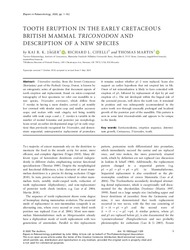Tooth eruption in the Early Cretaceous British mammal Triconodon and description of a new species
DOI: https://doi.org/10.1002/spp2.1329
Persistent URL: http://resolver.sub.uni-goettingen.de/purl?gldocs-11858/9244
Persistent URL: http://resolver.sub.uni-goettingen.de/purl?gldocs-11858/9244
Jäger, Kai R. K.; Cifelli, Richard L.; Martin, Thomas, 2020: Tooth eruption in the Early Cretaceous British mammal Triconodon and description of a new species. In: Papers in Palaeontology, DOI: 10.1002/spp2.1329.
 |
Dokument öffnen: |
Triconodon mordax, from the lowest Cretaceous (Berriasian) part of the Purbeck Group, Dorset, is known by an ontogenetic series of specimens that document aspects of tooth eruption and replacement. Based on micro-computed tomography of four specimens we refer one mandible to a new species, Triconodon averianovi, which differs from T. mordax in having a more slender, curved c; p4 notably low crowned with slender main cusp and smaller accessory cusps; and molars with weak cingula, m4 being notably smaller with weak cusps a and c. T. mordax is variable in the number of mental foramina and posterior jaw morphology. Scans reveal an earlier developmental stage (p3 in early eruption) than previously recognized for Triconodon, and demonstrate sequential, anteroposterior replacement of premolars; it remains unclear whether p1–2 were replaced. Scans also support an earlier hypothesis that m4 erupted late in life. Onset of m4 mineralization is likely to have coincided with eruption of p3, followed by replacement of dp4 by p4 and eruption of c. The m4 developed within the lingual side of the coronoid process, well above the tooth row. It remained in position and was subsequently accommodated in the active tooth row through unusually prolonged and localized growth of the posterior part of the mandible. This pattern is seen in some later triconodontids and appears to be unique to the family.
Statistik:
ZugriffsstatistikSammlung:
This is an open access article under the terms of the Creative Commons Attribution-NonCommercial License, which permits use, distribution and reproduction in any medium, provided the original work is properly cited and is not used for commercial purposes.

